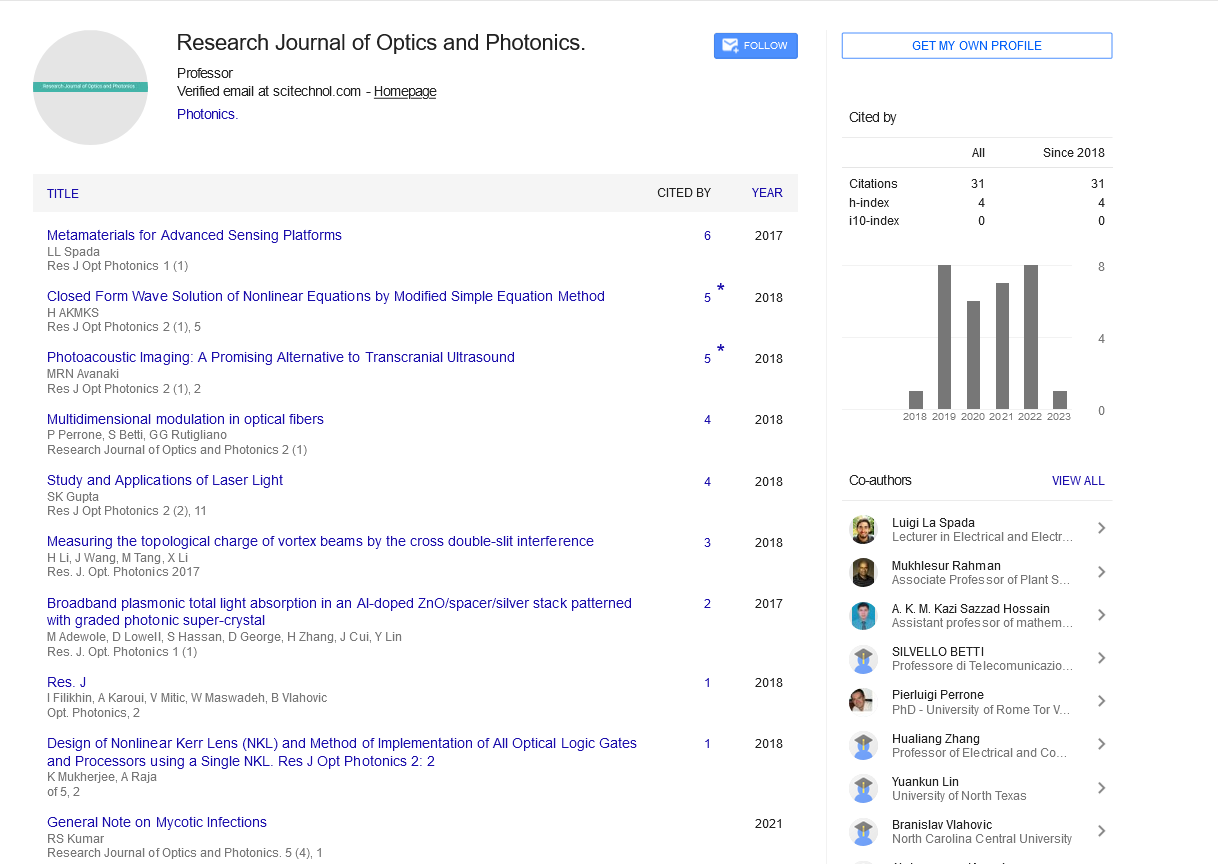Perspective, Res J Opt Photonics Vol: 7 Issue: 1
The Fundamentals and Applications of Physics Light Beam Propagation
Yulong Essam*
Department of Physics, Hebei Normal University, Shijiazhuang, China
*Corresponding Author: Yulong Essam
Department of Physics, Hebei Normal University, Shijiazhuang, China
E-mail: yulongessa@hnu.com
Received date: 03 February, 2023, Manuscript No. RJOP-23-96370;
Editor assigned date: 07 February, 2023, PreQC No. RJOP-23-96370 (PQ);
Reviewed date: 21 February, 2023, QC No. RJOP-23-96370;
Revised date: 28 February, 2023, Manuscript No. RJOP-23-96370 (R);
Published date: 07 March, 2023, DOI: 10.4172/RJOP.1000045
Citation: Essam Y (2023) The Fundamentals and Applications of Physics Light Beam Propagation. Res J Opt Photonics 7:1.
Description
The propagation of light beams is a fundamental concept in physics, with wide-ranging applications in various fields, including optics, photonics, telecommunications and imaging. Understanding the physics of light beam propagation is essential for designing and optimizing optical systems and devices for diverse applications.
Fundamentals of light beam propagation
The propagation of light beams is described by the laws of wave optics, which treat light as an electromagnetic wave. According to the wave theory of light, light beams propagate through space as transverse waves, with oscillations occurring perpendicular to the direction of propagation. The properties of light beams, such as their intensity, phase, polarization and wavelength, determine their behavior during propagation.
One of the key concepts in light beam propagation is diffraction, which refers to the bending and spreading of light waves as they pass through apertures or encounter obstacles. Diffraction limits the spatial resolution of optical systems and plays a vital role in determining the quality of optical images. The diffraction of light beams can be described by mathematical models, such as Fresnel and Fraunhofer diffraction, which provide insights into the behavior of light beams in various diffraction regimes.
Beam shaping and control
Light beams can be shaped and controlled to meet specific requirements in various applications. Beam shaping techniques, such as lenses, mirrors and spatial light modulators, can be used to manipulate the spatial profile, intensity distribution and polarization state of light beams. These techniques enable the generation of tailored light beams with desired properties, such as Gaussian, Bessel, or Airy beams, which find applications in areas such as microscopy, laser processing and optical trapping.
Advanced beam shaping techniques, including holography, metasurfaces and wave front engineering, provide precise control over the properties of light beams through manipulation of phase, amplitude and nanostructured surfaces, allowing for tailored intensity patterns, efficient propagation control and precise shaping of wave fronts.
Nonlinear effects in light beam propagation
Nonlinear effects play a significant role in the propagation of light beams, especially in high-intensity and ultrafast regimes. Nonlinearities arise when the intensity of light becomes sufficiently high to perturb the response of the medium. Nonlinear effects can lead to phenomena such as self-focusing, self-phase modulation and optical solitons, which have important implications for applications in laser physics, telecommunications and optical signal processing.
Nonlinear effects can also be harnessed for various applications, such as frequency conversion, optical parametric amplification and generation of super continuum spectra. These applications rely on the nonlinear response of materials to shape and control the properties of light beams. Understanding the underlying physics of nonlinear effects is important for designing and optimizing nonlinear optical systems and devices.
Applications of light beam propagation
The physics of light beam propagation finds applications in diverse fields. In telecommunications, the propagation of light beams through optical fibers enables high-speed data transmission over long distances, forming the backbone of modern communication networks. In imaging, the propagation of light beams through lenses and imaging systems determines the resolution, contrast and depth-of-field of optical images. In laser physics, the propagation of light beams through gain media determines the output power, beam quality and spectral characteristics of lasers, which have a wide range of applications in areas such as materials processing, medical treatments and scientific research.
Conclusion
The physics of light beam propagation encompasses fundamental principles and phenomena with interdisciplinary applications in science and technology, offering opportunities for designing and optimizing optical systems and devices through understanding of wave optics, diffraction, nonlinear effects and beam shaping at nanoscale and beyond.
 Spanish
Spanish  Chinese
Chinese  Russian
Russian  German
German  French
French  Japanese
Japanese  Portuguese
Portuguese  Hindi
Hindi 